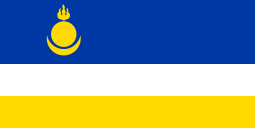Buryatia
The Republic of Buryatia (Russian: Респу́блика Буря́тия, tr. Respublika Buryatiya, IPA: [rʲɪsˈpublʲɪkə bʊˈrʲætʲɪjə]; Buryat: Буряад Улас, romanized: Buryaad Ulas, pronounced [bʊˈrʲɑːt ʊˈlɑs], Mongolian: Буриад Улс, romanized: Buriad Uls) is a federal subject of Russia (a republic), located in Siberia in Asia. Formerly part of the Siberian Federal District, it has been a part of the Russian Far East since 2018.[11] Its capital is the city of Ulan-Ude. Its area is 351,300 square kilometers (135,600 sq mi) with a population of 972,021 (2010 Census).[6]
Republic of Buryatia | |
|---|---|
| Республика Бурятия | |
| Other transcription(s) | |
| • Buryat | Буряад Улас |
 Coat of arms | |
| Anthem: Anthem of the Republic of Buryatia | |
.svg.png) | |
| Coordinates: 53°48′N 109°20′E | |
| Country | Russia |
| Federal district | Far Eastern[1] |
| Economic region | East Siberian[2] |
| Established | 30 May 1923 |
| Capital | Ulan-Ude |
| Government | |
| • Body | People's Khural[3] |
| • Head[3] | Alexey Tsydenov[4] |
| Area | |
| • Total | 351,300 km2 (135,600 sq mi) |
| Area rank | 15th |
| Population (2010 Census)[6] | |
| • Total | 972,021 |
| • Estimate (2018)[7] | 984,511 (+1.3%) |
| • Rank | 54th |
| • Density | 2.8/km2 (7.2/sq mi) |
| • Urban | 58.4% |
| • Rural | 41.6% |
| Time zone | UTC+8 (MSK+5 |
| ISO 3166 code | RU-BU |
| License plates | 03 |
| OKTMO ID | 81000000 |
| Official languages | Russian;[9] Buryat[10] |
| Website | http://egov-buryatia.ru/ |
Geography
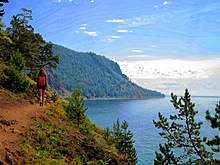
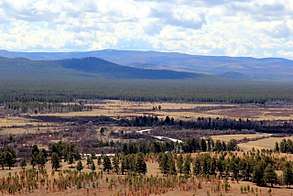
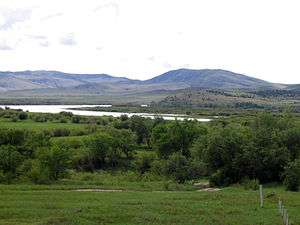
The republic is located in the south-central region of Siberia along the eastern shore of Lake Baikal.
- Area: 351,300 km²
- Borders:
- Internal: Irkutsk Oblast (W/NW/N), Zabaykalsky Krai (NE/E/SE/S), Tuva (W)
- International: Mongolia (Bulgan Province, Khövsgöl Province and Selenge Province) (S/SE)
- Water: Lake Baikal (N)
- Highest point: Mount Munku-Sardyk (3,491 m)
Rivers
Major rivers include:
- Barguzin River
- Irkut River
- Kitoy River
- Oka River
- Selenga River
- Uda River
- Upper Angara River
- Vitim River
Lakes
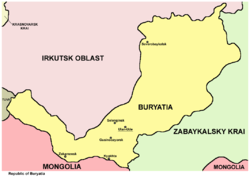
- Lake Baikal - Buryatia covers 60% percent of the lake's shoreline.
- Lake Gusinoye
Mountains
Over 80% of the republic's territory is located in the mountainous region, including the Baikal Mountains on the northern shores of Lake Baikal, the Ulan-Burgas east of the lake and the Selenga Highlands in the south near the Mongolia–Russia border.
Climate
- Average annual temperature: −1.6 °C (29.1 °F)
- Average January temperature: −22 °C (−8 °F)
- Average July temperature: +18 °C (64 °F)
- Average annual precipitation: 244 millimeters (9.6 in)
Administrative divisions
Demographics
Population: 972,021 (2010 Census);[6] 981,238 (2002 Census);[12] 1,041,119 (1989 Census).[13]
Settlements
| Census date | 1926 | 1939 | 1959 | 1970 | 1979 | 1989 | 2002 | 2010 |
|---|---|---|---|---|---|---|---|---|
| Total population | 491,236 | 545,766 | 673,326 | 812,251 | 899,398 | 1,038,252 | 981,238 | 972,021 |
| Average annual population growth | +1.7% | +1.1% | +1.5% | −0.4% | −0.1% | |||
| Males | 248,513 | 467,984 | ||||||
| Females | 242,723 | 513,254 | ||||||
| Females per 1000 males | 977 | 1,097 | ||||||
| Proportion urban | 9.3% | 59.6% | ||||||
| Territory (km2) | 368,392 | 351,334 | 351,334 | 351,334 | 351,334 | 351,334 | 351,334 | 351,334 |
| Population density/km2 | 1.3 | 1.6 | 1.9 | 2.3 | 2.6 | 3.0 | 2.8 | 2.8 |
Vital statistics
| Year | Average population (thousands) | Live births | Deaths | Natural change | Crude birth rate (per 1000) | Crude death rate (per 1000) | Natural change (per 1000) | Fertility rates |
|---|---|---|---|---|---|---|---|---|
| 1970 | 816 | 14,766 | 6,301 | 8,465 | 18.1 | 7.7 | 10.4 | |
| 1975 | 862 | 17,751 | 7,586 | 10,165 | 20.6 | 8.8 | 11.8 | |
| 1980 | 921 | 19,859 | 8,734 | 11,125 | 21.6 | 9.5 | 12.1 | |
| 1985 | 993 | 23,975 | 9,529 | 14,446 | 24.1 | 9.6 | 14.5 | |
| 1990 | 1,050 | 19,185 | 9,602 | 9,583 | 18.3 | 9.1 | 9.1 | 2.18 |
| 1991 | 1,052 | 16,868 | 9,753 | 7,115 | 16.0 | 9.3 | 6.8 | 2.03 |
| 1992 | 1,049 | 13,944 | 10,347 | 3,597 | 13.3 | 9.9 | 3.4 | 1.87 |
| 1993 | 1,043 | 11,981 | 12,388 | −407 | 11.5 | 11.9 | −0.4 | 1.65 |
| 1994 | 1,039 | 12,327 | 13,650 | −1,323 | 11.9 | 13.1 | −1.3 | 1.66 |
| 1995 | 1,035 | 12,311 | 12,588 | −277 | 11.9 | 12.2 | −0.3 | 1.60 |
| 1996 | 1,031 | 12,159 | 12,441 | −282 | 11.8 | 12.1 | −0.3 | 1.57 |
| 1997 | 1,025 | 11,555 | 12,111 | −556 | 11.3 | 11.8 | −0.5 | 1.51 |
| 1998 | 1,017 | 11,746 | 11,481 | 265 | 11.6 | 11.3 | 0.3 | 1.53 |
| 1999 | 1,009 | 11,468 | 13,114 | −1,646 | 11.4 | 13.0 | −1.6 | 1.42 |
| 2000 | 1,001 | 11,654 | 13,155 | −1,501 | 11.6 | 13.1 | −1.5 | 1.42 |
| 2001 | 992 | 11,678 | 13,858 | −2,180 | 11.8 | 14.0 | −2.2 | 1.44 |
| 2002 | 983 | 12,830 | 14,404 | −1,574 | 13.1 | 14.7 | −1.6 | 1.52 |
| 2003 | 977 | 13,177 | 15,056 | −1,879 | 13.5 | 15.4 | −1.9 | 1.51 |
| 2004 | 973 | 13,399 | 14,868 | −1,469 | 13.8 | 15.3 | −1.5 | 1.49 |
| 2005 | 969 | 13,551 | 15,144 | −1,593 | 14.0 | 15.6 | −1.6 | 1.41 |
| 2006 | 966 | 14,193 | 13,930 | 263 | 14.7 | 14.4 | 0.3 | 1.41 |
| 2007 | 965 | 15,460 | 12,802 | 2,658 | 16.0 | 13.3 | 2.8 | 1.60 |
| 2008 | 966 | 16,372 | 12,948 | 3,424 | 16.9 | 13.4 | 3.5 | 1.68 |
| 2009 | 968 | 16,729 | 12,466 | 4,263 | 17.3 | 12.9 | 4.4 | 2.03 |
| 2010 | 972 | 16,535 | 12,386 | 4,149 | 17.0 | 12.7 | 4.3 | 1.99 |
| 2011 | 972 | 16,507 | 12,299 | 4,208 | 17.0 | 12.7 | 4.3 | 2.03 |
| 2012 | 972 | 17,006 | 12,064 | 4,942 | 17.5 | 12.4 | 5.1 | 2.14 |
| 2013 | 973 | 17,108 | 11,479 | 5,629 | 17.6 | 11.8 | 5.8 | 2.21 |
| 2014 | 976 | 17,093 | 11,182 | 5,911 | 17.5 | 11.5 | 6.0 | 2.26 |
| 2015 | 980 | 16,981 | 11,152 | 5,829 | 17.3 | 11.4 | 5.9 | 2.28 |
| 2016 | 983 | 16,128 | 11,047 | 5,081 | 16.4 | 11.2 | 5.2 | 2.21(e) |
| 2017 | 984 | 14,315 | 10,445 | 3,870 | 14.5 | 10.6 | 3.9 | |
| 2018 | 984 | 13,892 | 10,347 | 3,545 | 14.1 | 10.5 | 3.6 |

Demographics for 2007
Source:[15]
| District | Births | Deaths | Growth | Pop (2007) | BR | DR | NGR |
|---|---|---|---|---|---|---|---|
| The Republic of Buryatia | 12,337 | 9,833 | 2,504 | 960,000 | 17.13 | 13.66 | 0.35% |
| Ulan-Ude | 4,260 | 3,517 | 743 | 373,300 | 15.22 | 12.56 | 0.27% |
| Bichursky District | 339 | 318 | 21 | 26,900 | 16.80 | 15.76 | 0.10% |
| Dzhidinsky District | 512 | 309 | 203 | 30,800 | 22.16 | 13.38 | 0.88% |
| Yeravninsky District | 244 | 191 | 53 | 18,600 | 17.49 | 13.69 | 0.38% |
| Zaigrayevsky District | 714 | 630 | 84 | 48,700 | 19.55 | 17.25 | 0.23% |
| Zakamensky District | 492 | 322 | 170 | 30,400 | 21.58 | 14.12 | 0.75% |
| Ivolginsky District | 498 | 320 | 178 | 31,000 | 21.42 | 13.76 | 0.77% |
| Kabansky District | 702 | 779 | −77 | 64,400 | 14.53 | 16.13 | −0.16% |
| Kizhinginsky District | 303 | 192 | 111 | 18,700 | 21.60 | 13.69 | 0.79% |
| Kyakhtinsky District | 629 | 393 | 236 | 40,500 | 20.71 | 12.94 | 0.78% |
| Mukhorshibirsky District | 338 | 319 | 19 | 28,000 | 16.10 | 15.19 | 0.09% |
| Pribaykalsky District | 423 | 357 | 66 | 28,900 | 19.52 | 16.47 | 0.30% |
| Selenginsky District | 628 | 522 | 106 | 47,500 | 17.63 | 14.65 | 0.30% |
| Tarbagataysky District | 205 | 216 | −11 | 16,900 | 16.17 | 17.04 | −0.09% |
| Tunkinsky District | 304 | 249 | 55 | 23,000 | 17.62 | 14.43 | 0.32% |
| Khorinsky District | 314 | 222 | 92 | 19,200 | 21.81 | 15.42 | 0.64% |
| Barguzinsky District | 367 | 272 | 95 | 25,600 | 19.11 | 14.17 | 0.49% |
| Bauntovsky Evenkiysky District | 126 | 92 | 34 | 10,500 | 16.00 | 11.68 | 0.43% |
| Kurumkansky District | 232 | 129 | 103 | 15,600 | 19.83 | 11.03 | 0.88% |
| Muysky District | 179 | 112 | 67 | 15,600 | 15.30 | 9.57 | 0.57% |
| Okinsky District | 73 | 37 | 36 | 5,100 | 19.08 | 9.67 | 0.94% |
| Severo-Baykalsky District | 196 | 161 | 35 | 15,200 | 17.19 | 14.12 | 0.31% |
| Severobaykalsk | 259 | 174 | 85 | 25,600 | 13.49 | 9.06 | 0.44% |
Ethnic groups
According to the 2010 Census,[6] ethnic Russians make up two-thirds of the republic's population, while the ethnic Buryats are only 30%. Other groups include Ukrainians (0.6%), Tatars (0.7%), and a host of smaller groups, each accounting for less than 0.5% of the total population.
| Ethnic group |
1926 Census1 | 1939 Census | 1959 Census | 1970 Census | 1979 Census | 1989 Census | 2002 Census | 2010 Census2 | ||||||||
|---|---|---|---|---|---|---|---|---|---|---|---|---|---|---|---|---|
| Number | % | Number | % | Number | % | Number | % | Number | % | Number | % | Number | % | Number | % | |
| Buryats | 214,957 | 43.8% | 116,382 | 21.3% | 135,798 | 20.2% | 178,660 | 22.0% | 206,860 | 23.0% | 249,525 | 24.0% | 272,910 | 27.8% | 286,839 | 30.0% |
| Soyots | 161 | 0.0% | 2,739 | 0.3% | 3,579 | 0.4% | ||||||||||
| Russians | 258,796 | 52.7% | 393,057 | 72.0% | 502,568 | 74.6% | 596,960 | 73.5% | 647,785 | 72.0% | 726,165 | 69.9% | 665,512 | 67.8% | 630,783 | 66.1% |
| Tatars | 3,092 | 0.6% | 3,840 | 0.7% | 8,058 | 1.2% | 9,991 | 1.2% | 10,290 | 1.1% | 10,496 | 1.0% | 8,189 | 0.8% | 6,813 | 0.7% |
| Ukrainians | 1,982 | 0.4% | 13,392 | 2.5% | 10,183 | 1.5% | 10,769 | 1.3% | 15,290 | 1.7% | 22,868 | 2.2% | 9,585 | 1.0% | 5,654 | 0.6% |
| Evenks | 2,808 | 0.6% | 1,818 | 0.3% | 1,335 | 0.2% | 1,685 | 0.2% | 1,543 | 0.2% | 1,679 | 0.2% | 2,334 | 0.2% | 2,974 | 0.3% |
| Others | 9,440 | 1.9% | 17,277 | 3.2% | 15,384 | 2.3% | 14,186 | 1.7% | 17,630 | 2.0% | 27,519 | 2.7% | 19,969 | 2.0% | 18,360 | 1.9% |
| 1 In 1926, the Buryat-Mongolian ASSR included Aga-Buryatia, Ust-Orda Buryatia, and Olkhonsky District. These territories were transferred to Chita and Irkutsk Oblasts in 1937. Consequently, the results of the 1926 census cannot be compared to the results of the censuses of 1939 and later.
2 17,019 people were registered from administrative databases, and could not declare an ethnicity. It is estimated that the proportion of ethnicities in this group is the same as that of the declared group.[16] | ||||||||||||||||
History

Mongolic-related Slab Grave cultural monuments are found in Baikal territory.[17] The territory of Buryatia has been governed by the Xiongnu Empire (209 BC-93 CE) and Mongolian Xianbei state (93-234), Rouran Khaganate (330-555), Mongol Empire (1206-1368) and Northern Yuan (1368-1691).[18] Medieval Mongol tribes like Merkit, Bayads, Barga Mongols and Tümeds inhabited in Buryatia.[18] Today Buryat-Mongols populate the territory of Buryatia.
The area of the present-day Buryatia was first colonized in the 17th century by Russians in search of wealth, furs, and gold.
In 1923, the Buryat-Mongolian Autonomous Soviet Socialist Republic (Buryat: Буряадай Автономито Совет Социалис Республика; Russian: Бурятская Автономная Советская Социалистическая Республика) was created as a result of the merger of State of Buryat-Mongolia and Mongol-Buryat Oblasts. In 1937, Aga Buryatia and Ust-Orda Buryatia were detached from the Buryat-Mongolian ASSR and merged with Chita and Irkutsk Oblasts, respectively. In 1958, the name "Mongol" was removed from the name of the republic. The Buryat ASSR declared its sovereignty in 1990 and adopted the name Republic of Buryatia in 1992. However, it remained an autonomous republic within the Russian Federation. On 11 July 1995 Buryatia signed a power-sharing agreement with the federal government, granting it autonomy.[19] This agreement would be abolished on 15 February 2002.[20]
Politics
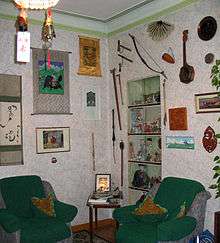
The head of the Republic is the Head (formerly President), who is elected by the voters of the republic for a four-year term. From 2004 to 2012 the head of Buryatia (along with all other heads of regions in Russia) was nominated directly by the Russian President.[21][22]
Between 1991–2007, the President was Leonid Vasilyevich Potapov, who was elected on July 1, 1994, re-elected in 1998 (with 63.25% of votes), and then re-elected again on June 23, 2002 (with over 67% of votes). Prior to the elections, Potapov was the Chairman of the Supreme Soviet of the Republic—the highest post at that time.
The current Head of the Republic is Alexey Tsydenov, who was elected by popular vote on 10 September 2017. Prior to this he was acting Head, having been appointed by Russian President Vladimir Putin in February 2017.[23]
The Republic's parliament is the People's Khural, popularly elected every five years. The People's Khural has 66 deputies and is currently dominated by the country's ruling party, United Russia, with 45 seats. Vladimir Anatolyevich Pavlov has been Chairman of the People's Khural since September 2019.
The Republic's Constitution was adopted on February 22, 1994.
Economy
The republic's economy is composed of agricultural and commercial products including wheat, vegetables, potatoes, timber, leather, graphite, and textiles. Fishing, hunting, fur farming, sheep and cattle farming, mining, stock raising, engineering, and food processing are also important economic generators.
Education
The higher education institutions of the republic include Buryat State University, Buryat State Academy of Agriculture, East Siberian State Academy of Arts and Culture, and East Siberia State University of Technology and Management.
Religion
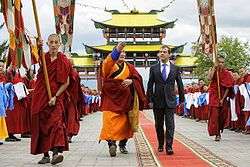
Traditionally, Buryats adhered to belief systems which were based on the deification of nature, belief in spirits and the possibility of their magic influence on the surroundings. They were led by shamans, who systematized tribal beliefs and cults. From the second half of the 17th century, beliefs and cults in the shamanic form were displaced by Buddhism, which became widespread in ethnic Buryatia. By the end of the 19th century, the majority of Buryats were part of the Buddhist tradition. A synthesis of Buddhism and traditional beliefs that formed a system of ecological traditions has constituted a major attribute of Buryat culture.[26]
As of a 2012 survey[24] 27.4% of the population adheres to the Russian Orthodox Church, 19.8% to Buddhism, 2% to the Slavic Native Faith, Tengrism or Buryat shamanism, 4% declares to be unaffiliated Christian (excluding Protestants), 1% are Orthodox Christian believers without belonging to churches or are members of other Orthodox churches, 1% are members of Protestant churches. In addition, 25% of the population declares to be "spiritual but not religious", 13% to be atheist, and 10.8% follows another religion or did not give an answer to the survey.[24]
Tibetan Buddhism and Orthodox Christianity are the most widespread religions in the republic. Many Slavs, who constitute around 67% of the population, are Russian Orthodox. Since the breakup of the USSR in 1991, a small number have converted to various Protestant denominations or to Rodnovery, Slavic native faith. There are also some Catholics among the Slavs. Most of the Germans (0.11% of the population) are also Orthodox, so are some other non-European groups like Armenians (0.23%), Georgians (0.03%), and Soyot (0.37%). Buryats constitute 30.04% of the total population.
Most urban Buryats are either Buddhist or Orthodox, while those in the rural areas often adhere to Yellow shamanism, a mixture of shamanism and Buddhism, or to Black shamanism.[27] There are also Tengrist movements. Siberian Tatars are around 0.7% of the population. However, due to isolation from the main body of Tatars, many of them now are either non-religious or Orthodox. Islam is followed by immigrant groups like Azeris and Uzbeks, who constitute another 0.7% of the population.
Tourism
Lake Baikal is a popular tourist destination, especially in summer.
References
- Президент Российской Федерации. Указ №849 от 13 мая 2000 г. «О полномочном представителе Президента Российской Федерации в федеральном округе». Вступил в силу 13 мая 2000 г. Опубликован: "Собрание законодательства РФ", No. 20, ст. 2112, 15 мая 2000 г. (President of the Russian Federation. Decree #849 of May 13, 2000 On the Plenipotentiary Representative of the President of the Russian Federation in a Federal District. Effective as of May 13, 2000.).
- Госстандарт Российской Федерации. №ОК 024-95 27 декабря 1995 г. «Общероссийский классификатор экономических регионов. 2. Экономические районы», в ред. Изменения №5/2001 ОКЭР. (Gosstandart of the Russian Federation. #OK 024-95 December 27, 1995 Russian Classification of Economic Regions. 2. Economic Regions, as amended by the Amendment #5/2001 OKER. ).
- Constitution, Article 5.3
- Ruling Party Dominates Russian Elections Amid Low Turnout, Opposition Claims Strong Moscow Showing
- Федеральная служба государственной статистики (Federal State Statistics Service) (2004-05-21). "Территория, число районов, населённых пунктов и сельских администраций по субъектам Российской Федерации (Territory, Number of Districts, Inhabited Localities, and Rural Administration by Federal Subjects of the Russian Federation)". Всероссийская перепись населения 2002 года (All-Russia Population Census of 2002) (in Russian). Federal State Statistics Service. Retrieved 2011-11-01.
- Russian Federal State Statistics Service (2011). "Всероссийская перепись населения 2010 года. Том 1" [2010 All-Russian Population Census, vol. 1]. Всероссийская перепись населения 2010 года [2010 All-Russia Population Census] (in Russian). Federal State Statistics Service.
- "26. Численность постоянного населения Российской Федерации по муниципальным образованиям на 1 января 2018 года". Federal State Statistics Service. Retrieved 23 January 2019.
- "Об исчислении времени". Официальный интернет-портал правовой информации (in Russian). 3 June 2011. Retrieved 19 January 2019.
- Official throughout the Russian Federation according to Article 68.1 of the Constitution of Russia.
- Constitution, Article 67
- "Официальный интернет-портал правовой информации". publication.pravo.gov.ru. Retrieved 2018-11-04.
- Russian Federal State Statistics Service (21 May 2004). "Численность населения России, субъектов Российской Федерации в составе федеральных округов, районов, городских поселений, сельских населённых пунктов – районных центров и сельских населённых пунктов с населением 3 тысячи и более человек" [Population of Russia, Its Federal Districts, Federal Subjects, Districts, Urban Localities, Rural Localities—Administrative Centers, and Rural Localities with Population of Over 3,000] (XLS). Всероссийская перепись населения 2002 года [All-Russia Population Census of 2002] (in Russian).
- "Всесоюзная перепись населения 1989 г. Численность наличного населения союзных и автономных республик, автономных областей и округов, краёв, областей, районов, городских поселений и сёл-райцентров" [All Union Population Census of 1989: Present Population of Union and Autonomous Republics, Autonomous Oblasts and Okrugs, Krais, Oblasts, Districts, Urban Settlements, and Villages Serving as District Administrative Centers]. Всесоюзная перепись населения 1989 года [All-Union Population Census of 1989] (in Russian). Институт демографии Национального исследовательского университета: Высшая школа экономики [Institute of Demography at the National Research University: Higher School of Economics]. 1989 – via Demoscope Weekly.
- Демографический ежегодник России [Demographic Yearbook of Russia] (in Russian). Retrieved 2017-10-19.
- "Archived copy". Archived from the original on 2011-02-04. Retrieved 2008-10-08.CS1 maint: archived copy as title (link)
- http://www.perepis-2010.ru/news/detail.php?ID=6936
- History of Mongolia, Volume I, 2003
- History of Mongolia, Volume II, 2003
- Solnick, Steven (29 May 1996). "Asymmetries in Russian Federation Bargaining" (PDF). The National Council for Soviet and East European Research: 12. Archived from the original (PDF) on 28 August 2017. Retrieved 6 May 2019.
- Chuman, Mizuki. "The Rise and Fall of Power-Sharing Treaties Between Center and Regions in Post-Soviet Russia" (PDF). Demokratizatsiya: 146. Archived from the original (PDF) on 2019-03-08. Retrieved 2019-05-06.
- Putin signs law to allow him to pick Russian governors
- Russia reinstates governor elections
- "Arena: Atlas of Religions and Nationalities in Russia". Sreda, 2012.
- 2012 Arena Atlas Religion Maps. "Ogonek", № 34 (5243), 27/08/2012. Retrieved 21/04/2017. Archived.
- Esuna Dugarova. Buryatia – a symbol of Eurasia in the heartland of Baikal. UN Special (magazine)
- Shimamura, Ippei (2014). The Roots Seekers: Shamanism and Ethnicity among the Mongol Buryats. Yokohama, Tanagawa, Japan: Shumpusha Publishing. ISBN 978-4-86110-397-1.
Sources
- Верховный Совет Республики Бурятия. 22 февраля 1994 г. «Республика Бурятия. Конституция», в ред. Закона №332-IV от 7 июля 2008 г. (Supreme Council of the Republic of Buryatia. February 22, 1994 Republic of Buryatia. Constitution, as amended by the Law #332-IV of July 7, 2008. ).
Further reading
- Leisse, Olaf; Utta-Kristin Leisse (September 2007). "A Siberian Challenge: Dealing with Multiethnicity in the Republic of Buryatia". Nationalities Papers. 35 (4): 773–788. doi:10.1080/00905990701475178.
- Anthology of Buryat folklore, Pushkinskiĭ dom, 2000 (CD)
External links
| Wikimedia Commons has media related to Buryatia. |
- Buryatia at the Encyclopædia Britannica
- Official website of the Republic of Buryatia
- (in Russian) Official website of the Republic of Buryatia
- Official website of the Republic of Buryatia (in Buryat)
- (in Russian) Buryatia.org, site about life in the Republic of Buryatia
- Article on Buddhism in Buryatia and Mongolia
- (in Russian) Informational website of Buryatia
